|
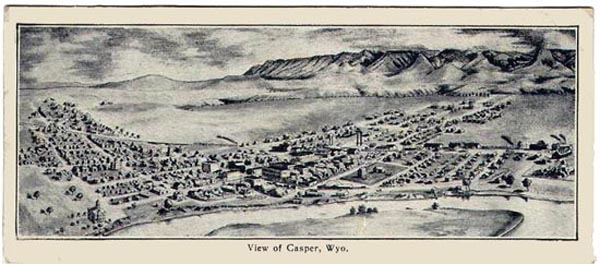
Casper, Bird's Eye View, approx. 1918.
With the arrival of the railroad in 1888, Casper became a prime shipping point for wool rapidly replacing
Rawlins as the center of wool production in the state. In the same year George Weber formed the Bank of Casper.
In 1891 he sold the bank to lawyer and ranchman
William Ascan Denecke (1861-1947) who continued operation of the bank as W. A. Deneck & Co.. Denecke was a partner with Nathan S. Bristol in
an adjacent ranch supply house known as N. S. Bristol & Co. Bristol was a well respected businessman of Casper, a 32nd Degree Scottish Rite, a Trustee of the University
of Wyoming. Additionally, Denecke was also partner with John Wright in Denecke & Wright Sheep Co. operating out of
Bates Hole. In 1889, C. H. King, Gerald Ford's grandfather, formed a competeing bank. Nevertheless, the
town grew but slowly. In 1890, it had a population of 544. Ten years later it had grown to 883. Nevertheless, the little town
had a Congregational Church, two newspapers, and an assortment of saloons.
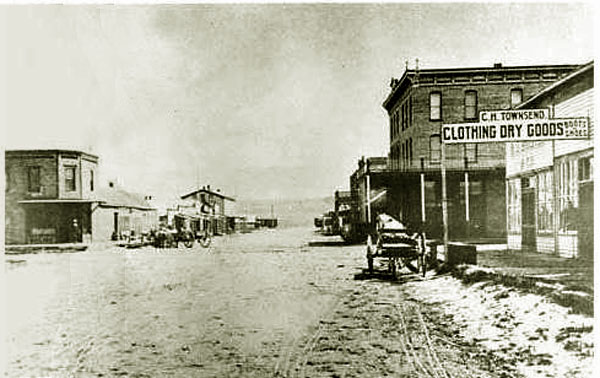
Casper looking south on Center Street, 1893.
In the above photograph, the two-story building is W.A. Denecke & Co. (the Bank of Casper), next is
N. S. Bristol & Company, Wholesale and Retail Dealers in Groceries, Flour, Feed, Grain & Hay. Beyond is the Nobrara Hotel.
On the right is C. H. Townsend. The three-story building is the Grand Central Hotel.
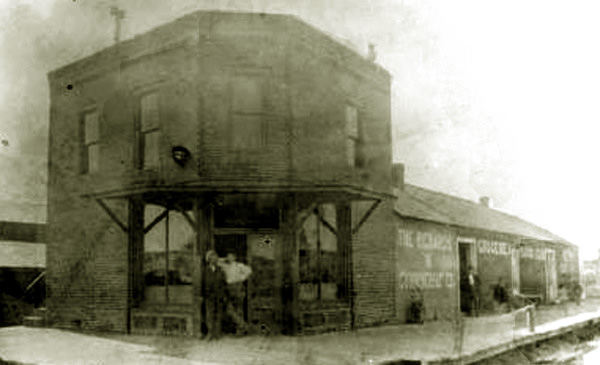
W. A. Denecke' Bank of Casper, 1893. To the right of the Bank is N. S. Bristol & Comany, Wholesale & Retail Dealers in Grocercies, Flour, Feed, Grain & Hay.
During the summer of 1893 a number of larger depositors in the Bank of Casper began withdrawing their accounts. On November, 27, 1903, the bank failed. One-Half hour
after the bank closed its doors, N. S. Bristol closed. Investigation reflected that the various partners were engaged in self-dealing and that the vast bulk of the
deposits left in the bank were held in unsecured loans to N.S. Bristol, Denecke &Wright Sheep Co. John wright, and Bristol & Wright. Another partner in the various enerprises included
Charles Weston, the Nebraska State Auditory. The moneys had been used to purchase livestock for the ranches and in the store.
All the partners were arrested. Weston was removed from a train in Douglas. He had been heading back to
Nebraska. Denecke was able to repay his loans.
The charges wwere dismissed upon a petitioned by the bulk of the depositors. Ultimately, all of the depositors were able to recover
their funds. Denecke and Wright moved to Idaho. The depositors who had removed their funds, promptly formed a new federally insured bank with
C. H. Townsend, Bristol's son-in-law, as its president. Townsend additionally announced his "new store" which added a line
of groceries.
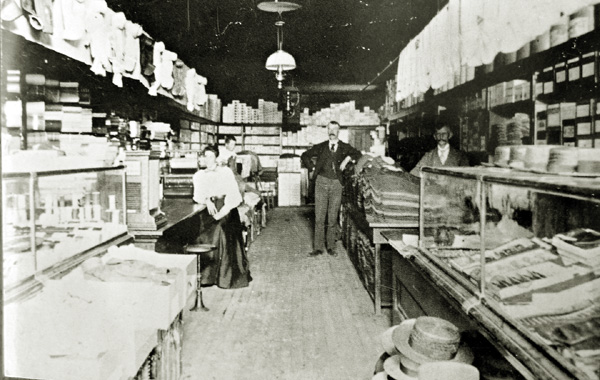
Interior C. H. Townsend' drygoods store 1900.
In 1896, Williams, Cooper and Nephew installed steam shearing pens in Casper. Two other hand pens were also in
Casper, one on the Platte and the other at Casper Creek. The steam powered shearers were regarded as a wonder of the
age. In 1897, Mrs. Mary E. Partridge, the Grand Most Worthy Matron of the Grand General Chapter of
the Order of the Eastern star made an official visit to the Casper Chapter. Casper was the end of the rail line and Mrs. Partidge's transportation into
Casper was on a mixed freight and "accommodation" train, i. e. a local which stops at every station.
At the time, no Grand Chapter had yet been
formed in Wyoming. Thus, the chapter was directly subordinate to the Grand General Chapter. Generally speaking, when a
"Grand" is making an official visit all the stops are pulled out. He or she is put up in the
best hotel, banqueted, and witnesses an exemplification of the ritual. Mrs. Partridge was put up at the
newly renovated Hotel Natrona. Generally, the town will put its best foot forward and will demonstrate the best attributes of the
town. Mrs. Partrige was given a tour of the sheep pens and witnessed a demonstration of the mechanical shearing.
The almost 70 year-old District Deputy, who had instituted the chapter three years before, rode some 56 miles in a lumber wagon to
attend the official visit. At the time, Casper was the largest shipper of wool in the United
State. The sheep shearers were paid piece work, eight cents per sheep.
Other shearing pens were located further to the west at Wolton, Lost Cabin, and Lander.
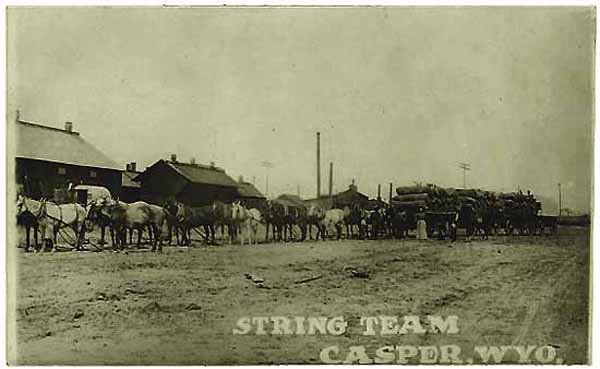
Wool Train, Casper, approx. 1900.
The Wyoming Derrick, Jan 11, 1900, estimated that by the end of the year the total value of sheepin Wyoming
would exceed that of cattle. In 1895 it was that 4,000,000 lbs. of wood was shipped from
Casper. By May 1903 estimated that 7,500,000 lbs of wool was shipped from Casper in that year's clip. As a result of Casper's central
location most of the wool came into Casper by giant 16 hitch "string teams" pulling multiple wagons from as far away as
Fremont County.
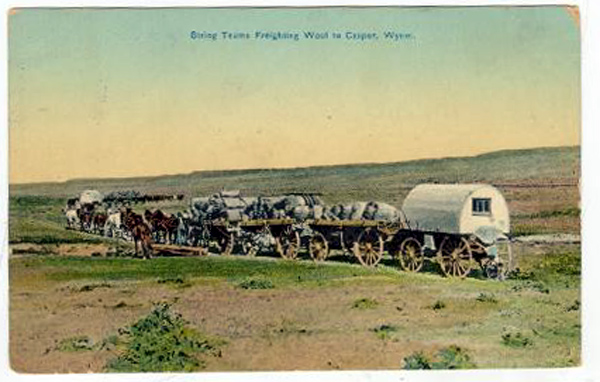
Hauling Wool to Casper, approx. 1909.
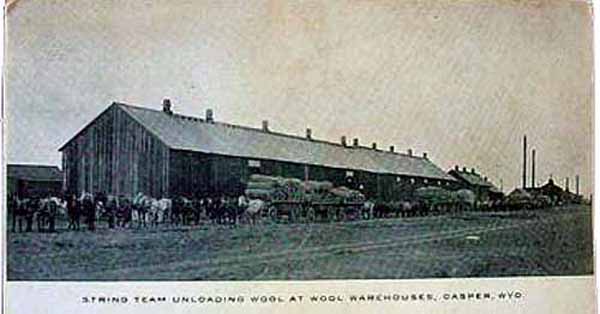
Wool Warehouse, Casper, approx. 1900.
The warehouses were some 170 feet long and 40 feet wide.
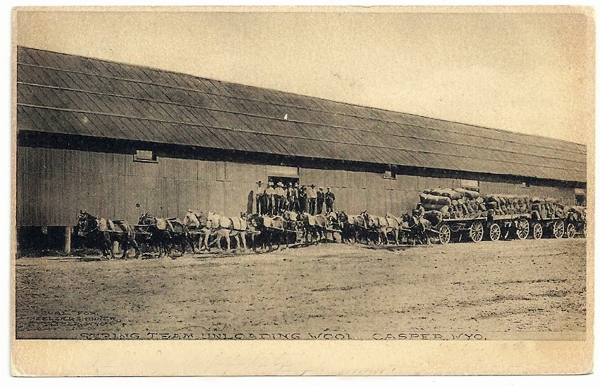
Wool String Teams unloading at Casper's warehouses.
On March 14, 1917, the warehouses caught fire just as an eastbound
passenger train was pulling in. The train was moved to safety. At the time the west section of the warehouse was used by
C. H. Townsend to store hay and bulk salt. The center portion was occupied by Richardson and Cunningham for miscellaneous goods. The final
portion was used by the railroad and to store freight for the Midwest Refining Company. In addition to loss of the warehouses and their contents estimated at
$25,000 to $35,000 dollars, the poles supporting the Western Union lines burned cutting the city off from
communication with Denver. Communication was reestablsihed using Burlington lines through Omaha.
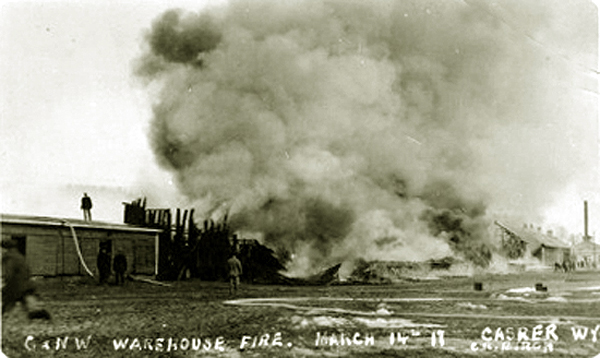
Chicago & Northwestern Warehouse fire, March 14, 1917.
At the time, it was regarded by the Tribune as the largest fire Casper had known since the Sprague Brothers Livery Barn burned in the
early morning hours of August 5, 1905. In actuality, the monetary losses from the burning of the wool warehouses were greater.
The financial loss from the burning of the livery was less, only an estimated $12,000 to $15,000. The livery fire was, however, more horrific.
Some 50 horses and mules were in the livery. Only 22 animals could be rescued before the heat of the flames drove
rescuers back. From the rear of the stable the distress and screams of agony from the animals could be seen and
heard. Especially pitiful was one calf attempting to beat its way through the wall of its pen. When the stable fire was discovered,
one of the propietors, Ernest Sprague, could not get on the telephone through "Central" to the fire department and had to run the five blocks to the
fire house and ring the fire bell. Others to alert town firemen fired their guns into the air.
The year following the arrival of the railroad, Natrona County was formed with Casper competing with Bessimer Bend to be the seat.
Bessimer Bend is now a ghost town. But like a number of other end-of-the-track towns, Casper tended to be a bit "wild and woolly." Hence, newly elected
sheriff, William W. Jaycox, had his hands full. During the Indian Wars, Jaycox had served as a packer in Gen. George Crook's
campaign in northern Wyoming and Dakota Territory. Two popular establishments in the newly-formed city were Louella Polk's dance hall and sporting establishment and
"Black Dogue" Lee's saloon. For a while, Dogue acted as Louella's paramour, but her eyes turned to John C. Conway, one of her bartenders in her
sporting facility.
In a moment of jealous rage, Dogue kidnapped Louella. An impromptude posse of Louella's customers was organized to give chase. As the posse
neared, Dogue forced Louella to dismount from the horse and threw her on the ground. If he could not have her, he determined that no one
else would want her. Dogue then proceeded to conduct surgery on Louella's nose with a pen knife. Dogue then departed, not to be seen again, leaving
Louella to be returned to Casper by the posse. Efforts by a physician to sew the nose back on proved to be unsuccessful.
As a form of recompense for her disfigurement, Louella took over operation of Lee's saloon. Conway served as one of the bartenders.
To prevent things from getting completely out-of-hand in the saloon, house rules required the customers to check-in their
hardware when they entered. For the protection of the bartenders, however, Louella had a suitable firearm beneath the bar.
One night, an F L Cattle Company cowboy named A. J. "Red Jack" Tidwell and the bartender Conway got into a merry little
fistfight. Conway, seeking to end the melee, perhaps unfairly, reached for the gun below the bar. When the firing started,
all the customers, including Tidwell, rushed for the doorway. Unfortunately in the stampede, Tidwell accidently stumbled, tripped, and fell into the path of one of
Conway's bullets from the effects of which Tidwell expired.
With Jack Tidwell lying dead in Louella's new saloon, things began to get a little heated. The cowboys began to organize a festivity featuring a rope in
Conway's honor. Sheriff Jaycox was able to spirit Conway away. The Sheriff returned Conway to town only after things cooled down.
Nevertheless, Conway was indicted for the first degree murder of Tidwell. He pled not guilty. His lawyer for some unexplained reason suddenly and without
notice then vanished.
In order to avoid a possible death penalty, Conway's new
lawyer was able to convince Conway to plead to second degree murder. When asked whether he agreed to withdraw his
not guilty plea, he was loudly sobbing, in tears and wailing. All agreed, however, that he had nodded his head yes. When sentenced to twenty-five years
in the State Penitentiary in Laramie City, Conway demurred and indicated that he had not agreed to withdraw his not guilty plea. The
recantation of the plea was denied by the judge. On appeal, the Wyoming Supreme Court held that if there is no record, the remembrance of
the trial judge must be upheld. Since the nodding of the head was not verbally expressed, there was no record upon which to
overturn the sentence. Accordingly, the sentence and prior law relating to the necessity of a court record
was sustained. See State ex rel. Conway v. Blake,
5 Wyo. 107, 38 P. 354, (Wyo. 1894).
The law in mysterious ways its wonders work. After a slight but decent interval, Conway was pardoned.
While Conway's adventures were pending, Sheriff Jaycox, in the word of the Board of County Commissionrs, "fled" town for Montana* without bidding his friends "goodbye" or, for that matter,
even having the courtesy to telegraph back a resignation. In Montana, Jaycox was employed as a foreman for the American Cattle and Loan Company in Valley County, Montana.
Casper historian A. J. Mokler indicates that the reason for Jaycox's hasty departure was
unspecified "domestic troubles."
[*Writer's note: Mokler does not indicate to where the Sheriff fled. BLM land patents indicate that William W. Jaycox
homesteaded land near Glasgow, Montana. See also American Live Stock & Loan [sic] Co. v. Great Northern Ry. Co., 48 Mont. 495, 138 P. 1102 (1914).
"Dogue" is usually defined as a type of mastiff.] Additionally, there was at
least one shootout in the public streets. One such shootout on Center Street involving the mayor and a cowboy in Center Street resulted in a
two bullets entering the Pioneer Drug Store. The mayor was the better shot.]
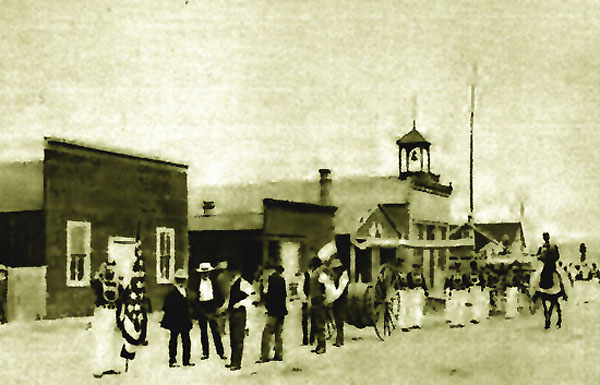
Casper Fire Department, July 4, 1891. The building with the bell tower is the new Town Hall.
The fire Department's equipment all on display consisted of the hose cart with 150 feet of hose, a nozzle, and a trumpet for the
chief. The uniforms conssted of blue shirts with red collars and red belts for the trousers. Casper historian Alfred Mokler,
History of Natrona county, Wyoming, 1888-1922, Lakeside Press, Chicago, 1923, p. 159, questioned the use of
the hose cart, hose, and nozzle, since at the time there was no force fed water system. The firemen
relied upon bucket brigades which received water from four polluted wells on Center Street. Drinking water was brought in from
Elkhorn and Garden Creeks. Later, F. E. Seeley sold drinking water from Garden Creek by either the barrel or half barrel lots at thirty-five
cents a barrel.
Next page Casper continued, Mineral on Casper Mountain, the Great Asbestos Scam.
|